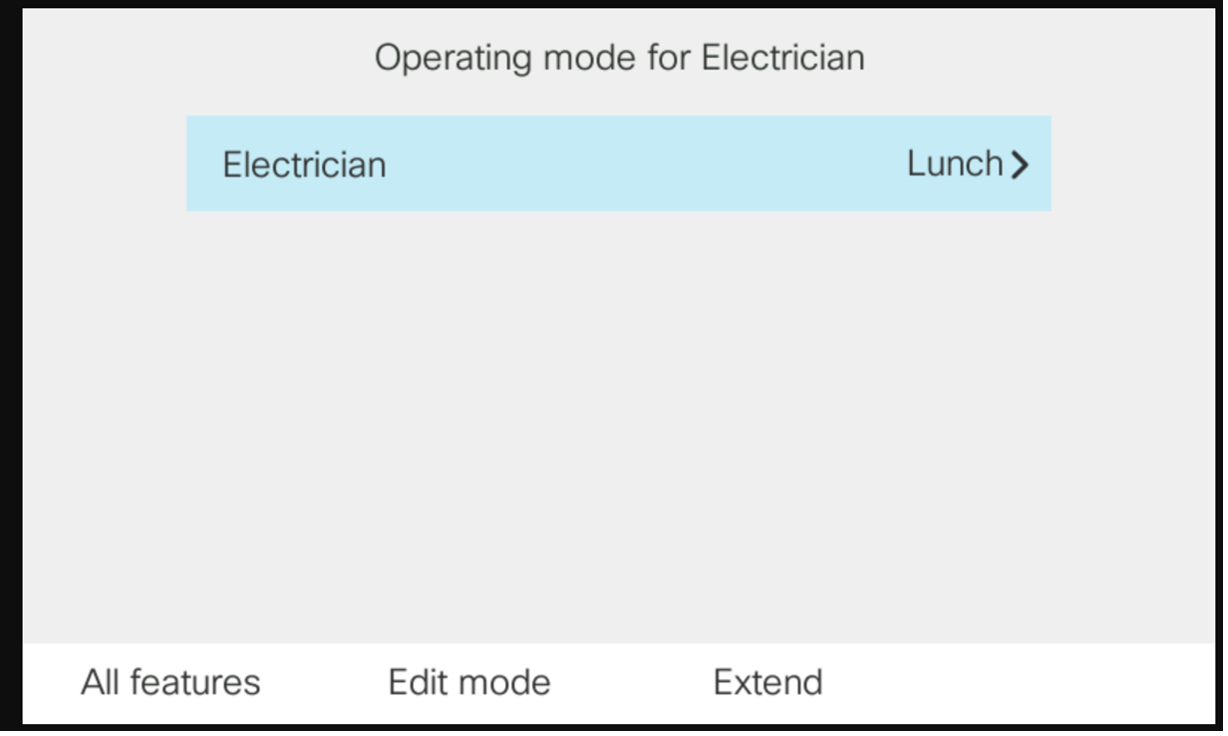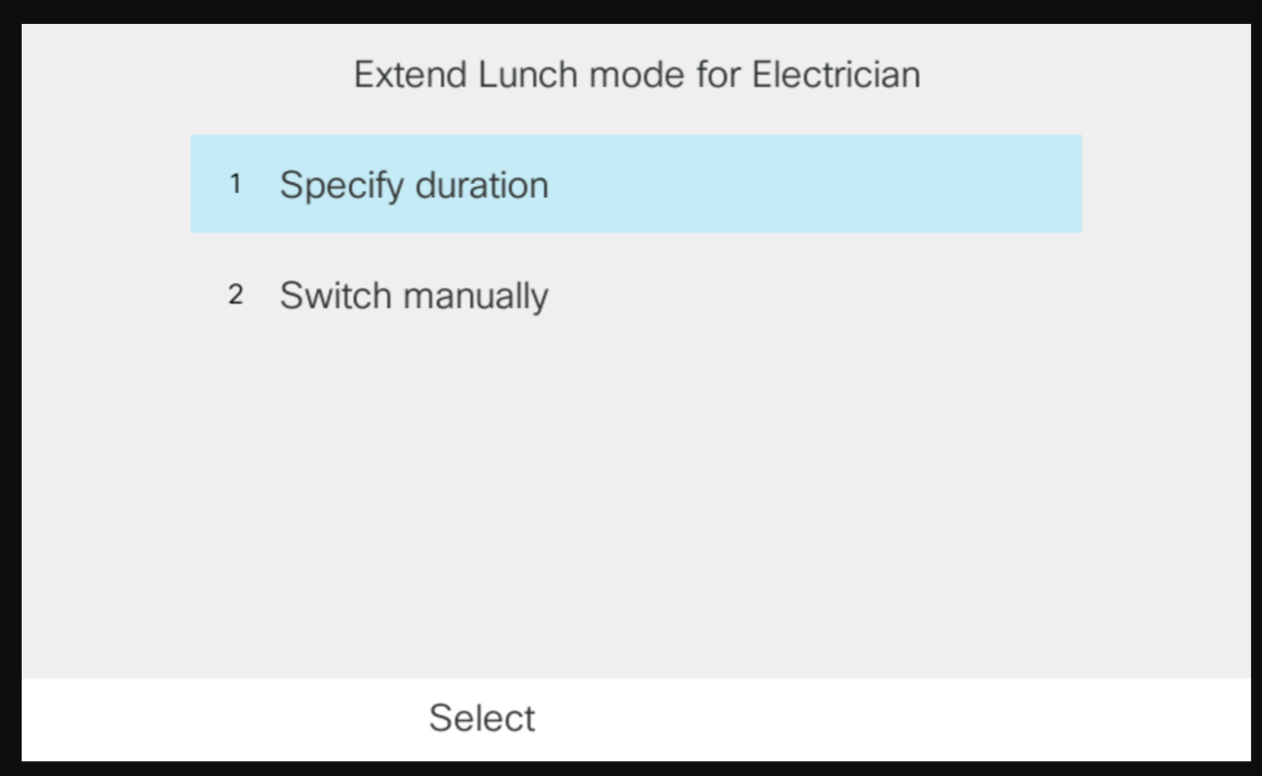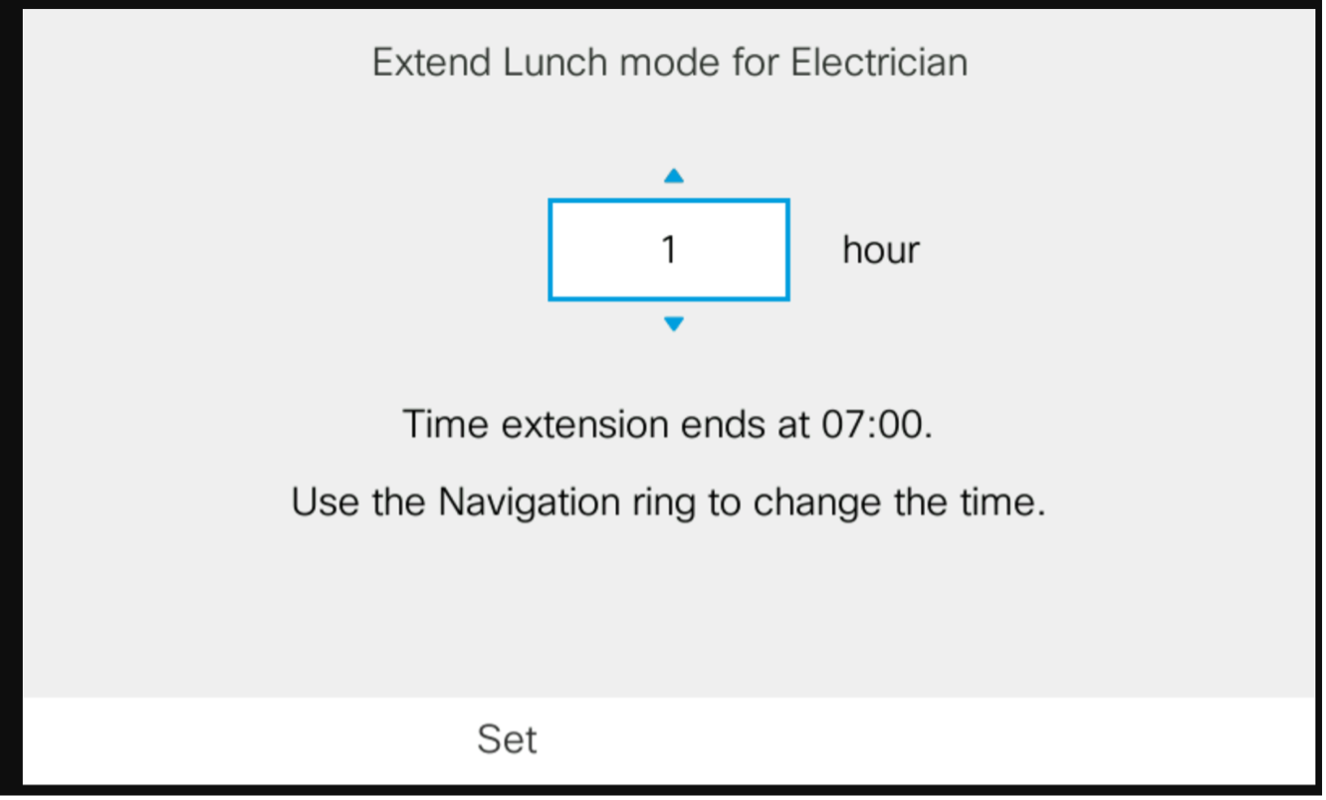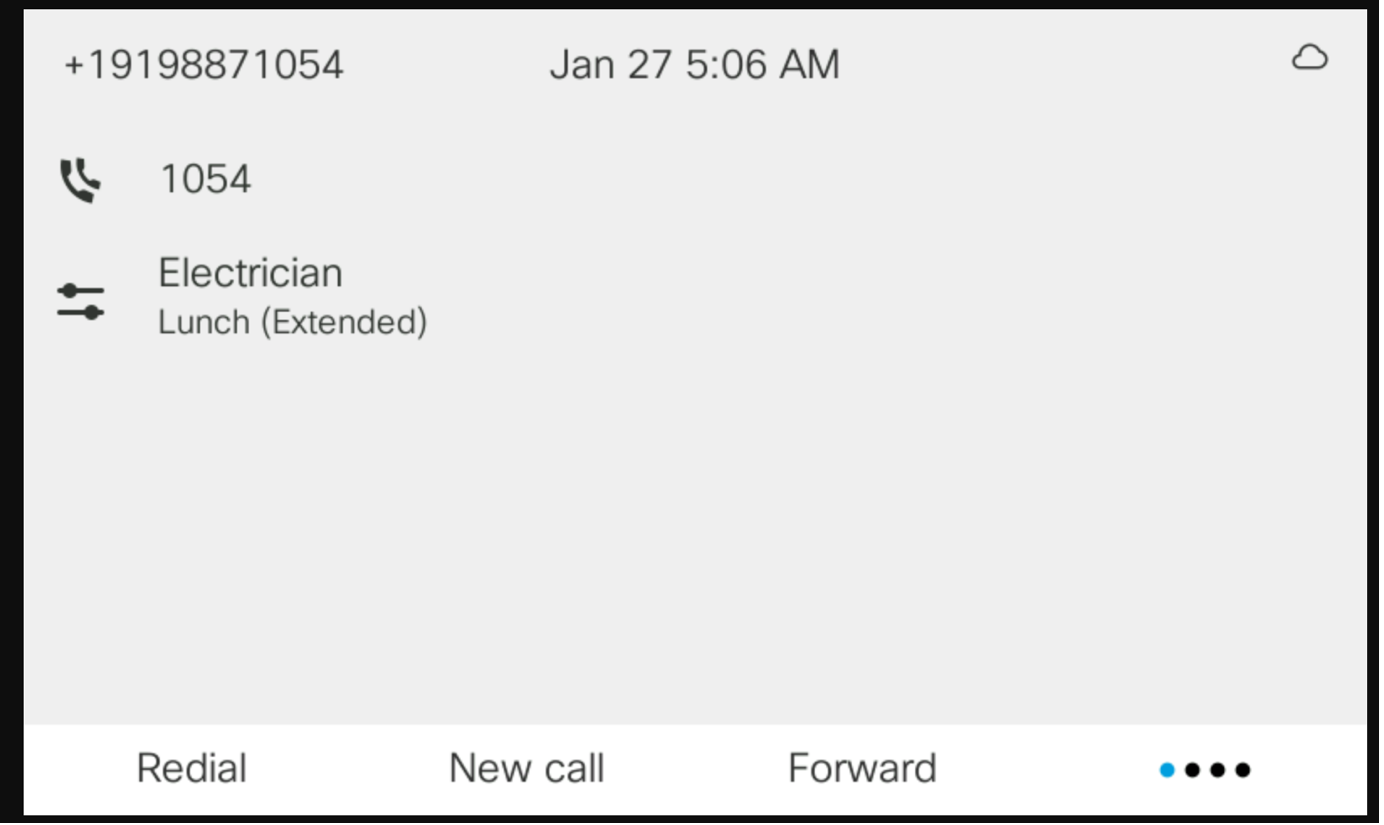- 홈
- /
- 문서







Webex Calling의 운영 모드에 따른 통화 라우팅
 이 문서에서
이 문서에서 피드백이 있습니까?
피드백이 있습니까?운영 모드에 따른 통화 라우팅을 통해 기업은 통화 를 조직 내 다양한 목적지, 사용자 및 부서로 효율적으로 연결할 수 있으며, 권한이 있는 사용자 에게 라우팅 프로세스를 관리할 수 있는 권한을 부여할 수도 있습니다.
기업에서는 하루 중 시간대와 요일에 따라 수신 전화를 다양한 사용자나 사용자 그룹에 효과적으로 연결하는 것이 중요합니다. 예를 들어, 영업 시간 중에는 전화가 접수 담당자에게 연결되고, 영업 시간 외에는 전화가 자동 안내원이나 음성 메일로 연결될 수 있습니다. 시간대별 라우팅을 활용하면 기업은 하루 중 다양한 시간대에 걸쳐 통화와 리소스를 효율적으로 관리할 수 있습니다.
운영 모드에 따른 통화 라우팅을 통해 기업은 다음을 수행할 수 있습니다.
-
수신 전화를 자동으로 올바른 목적지로 연결합니다.
-
시간, 요일, 업무 요구 사항에 따라 통화 흐름을 효율적으로 관리합니다.
-
권한이 있는 사용자가 데스크폰과 사용자 허브에서 모드를 변경할 수 있도록 하여 다양한 통화 시나리오를 처리하는 데 있어 유연성을 제공합니다.
작동 모드
운영 모드는 다양한 시간과 시나리오에서 통화가 처리되는 방식을 결정하는 유연한 통화 라우팅 구성입니다. 예를 들면,
-
주간 모드- 일반 영업 시간 라우팅
-
야간 모드- 근무시간 외 통화 처리
-
Holiday/Special 폐쇄 모드 - 주말 또는 공휴일 라우팅
작동 모드 유형:
다음 운영 모드는 특정 일정 및 운영 요구 사항을 해결하도록 설계되었습니다.
-
예약 모드:
-
매일 같은 시간
-
매일 다른 시간
-
휴일별 경로
-
-
비예약 모드 - 특정 시간 제약이 없는 표준 작업입니다. 고객에 대한 일정이 정의된 경우, 예정되지 않은 모드는 예정된 시간 외에 활성화됩니다.
장점
모드 기반 통화 라우팅은 통화 관리 효율성을 높이고 원활한 고객 경험을 보장하기 위해 다음과 같은 기능을 제공합니다.
-
유연성: 귀사의 비즈니스 요구 사항에 맞춰 통화 라우팅을 맞춤 설정하세요.
-
효율성: 자동으로 통화를 적절한 부서로 연결합니다.
-
전문성: 전화는 항상 적절하게 처리되도록 하세요.
운영 모드 설정
작동 모드를 생성하려면:
-
Control Hub에 로그인합니다.
-
로 이동 호출 > 특징 > 작동 모드.
-
새로 추가를 클릭합니다.
-
모드를 생성하려면 조직 또는 위치 수준을 선택하세요.

위치를 선택한 경우, 목록에서 위치를 검색하거나 선택하세요.
-
모드 이름을 입력하고 다음을 클릭합니다.
-
운영 모드에 일정이 포함된 경우 일정 정의 를 켜고 목록에서 일정 유형을 선택합니다.
-
매일 같은 시간으로 예약 - 드롭다운 목록에서 이 옵션을 선택하고 월요일-금요일 또는 토요일 옆에 있는 상자를 체크합니다. & 해. 시간 범위를 지정하고 해당되는 경우 종일 을 선택하세요.
-
매일 다른 시간으로 예약 - 드롭다운 목록에서 이 옵션을 선택하고 요일 옆에 있는 상자를 체크하세요. 시간 범위를 지정하고 해당되는 경우 종일 을 선택하세요.
-
휴일로 예약 - 드롭다운 목록에서 이 옵션을 선택하고 휴일 이름, 반복 및 기간을 입력합니다. 해당되는 경우 종일 을 선택하세요.
반복 매년으로 전환하면 기간 시작일과 종료일이 동일하고 종일 토글이 기본적으로 켜져 있습니다.
다음을 선택합니다. 새로운 휴일이 테이블에 저장됩니다. 새 휴일 추가를 클릭하면 여러 휴일 항목을 추가할 수 있습니다. 휴일 위에 마우스를 올려놓고
 을 클릭하여 휴일을 편집하거나
을 클릭하여 휴일을 편집하거나  을 클릭하여 휴일을 삭제합니다.
을 클릭하여 휴일을 삭제합니다. -
-
다음을 클릭합니다. 전달 대상 페이지가 나타납니다. 목적지를 입력하고, 해당되는 경우 음성 메일로 보내기 상자를 체크하세요. 또는 전달 안 함 을 선택하고 다음을 클릭합니다.
-
새로운 작동 모드에 대한 설정을 검토하세요.
일정 유형 운영 모드는 모드가 생성된 후에는 변경할 수 없습니다.
-
만들기를 클릭합니다.
위치 관리자 제한 사항
위치 수준 관리자는 자신의 위치에 대한 모드를 생성, 업데이트, 삭제할 수 있습니다.
관리 버튼의 대량 관리 드롭다운 목록을 사용하여 운영 모드를 대량으로 구성할 수 있습니다.
기능 통화 전달 모드 프로비저닝
Customer Experience Essentials 통화 대기열, 자동 전화 교환, 통화 대기열 및 헌트 그룹에 대한 통화 전달 구성에 모드별 통화 전달 옵션이 추가되었습니다. 조직 수준 모드와 기능 위치의 모드는 모드별로 콜 전달에 할당될 수 있습니다.
기능에 대한 정상 작동 일정은 정상 작동을 위해 활성화된 하나 이상의 모드로 구성되며, 이러한 모드를 통해 호출은 이러한 모드의 순서와 일정에 따라 라우팅됩니다.
정상 작동 일정 에는 정상 작동에 활성화된 모드에서 다루지 않는 기간도 포함됩니다. 이 기간 동안 해당 기능은 현재 모드가 없는 "정상 작동" 상태로 간주됩니다.
정상 작동이 수동으로 재정의되면 해당 모드는 예외 모드로 간주됩니다. 예를 들어, 사무실 관리자와 같은 권한이 있는 사용자가 오후 4시 이후로 업무 시간을 연장하면 업무 시간 모드는 예외 모드로 전환됩니다. 예외 모드는 자동으로 정상 작동 모드로 전환될 수도 있고, 수동으로 정상 작동 모드로 다시 전환될 수도 있습니다.
할당된 각 모드는 해당 모드의 기본 전달 구성을 사용하거나 자체 사용자 정의 전달(다른 전달 대상 또는 전달 안 함)을 지정하도록 구성할 수 있습니다.
할당된 모드의 순서는 기능의 정상적인 작동에 대한 우선순위를 제어하며, 관리자는 Control Hub에서 드래그 앤 드롭을 사용하여 목록을 다시 정렬할 수 있습니다.
-
모드 기반 전달을 활성화하려면 해당 기능에 최소한 하나의 모드가 할당되어야 합니다.
-
에이 scheduled/holiday 모드의 dates/times 해당 기능의 시간대에 따라 적용됩니다.
이 기능은 Webex Calling 고객이 통화 대기열, 통화 대기열, 자동 전화 교환원또는 헌트 그룹 모드가 할당된 것을 의미합니다.
해당 기능의 현재 모드(있는 경우)는 목록에 색상 점으로 태그되어 모드 상태를 나타냅니다.
-
녹색 = 정상 작동.
-
호박색 = 자동 전환(조기 시작 또는 연장) 예외.
-
빨간색 = 수동 스위치 백 예외.
현재 모드의 상태가 정상 작동이 아닌 경우, 관리자는 해당 기능을 정상 작동으로 다시 전환할 수 있습니다.
기능에 모드 기반 전달 할당
모드 기반 통화 라우팅은 통화 대기열과 같은 기능에 모드를 할당하여 활성화되며, 이 기능에 대한 통화 라우팅을 수정해야 합니다.
모드 기반 라우팅의 기능을 할당하려면:
-
Control Hub에 로그인합니다.
-
로 이동 호출 > 통화 대기열.
-
목록에서 통화 대기열을 선택하고 통화 전달을 클릭하세요.

-
통화 전달 을 전환하고 모드별 통화 전달을 선택합니다.
-
기존 모드를 선택하세요.
-
모드가 예약된 경우 기본적으로 일반 작동 토글이 선택됩니다.
-
옵션을 선택합니다. 기본 전화번호, 다른 전화번호, 또는 전달하지 않음. 전달하지 않음 외의 다른 옵션을 선택하는 경우 목적지를 지정하세요. 해당되는 경우 음성 메일로 보내기 를 전환합니다.
저장을 클릭합니다. 새로운 모드가 통화 전달 목록에 나타납니다.
일반 동작 토글을 선택하세요.-
추가 모드를 추가하려면 작동 모드 추가 를 클릭하세요.
-
모드를 편집하려면
 을 선택하고, 삭제하려면
을 선택하고, 삭제하려면  을 선택하세요.
을 선택하세요.
위치 관리자 제한 사항
위치 관리자에게는 다음과 같은 제한이 적용됩니다.
-
위치 관리자는 위치 내 기능에 대한 보기, 할당, 편집, 할당 해제 등의 모드를 관리할 수 있습니다.
-
Customer Experience Essentials, 자동 전화 교환원, 통화 대기열 및 헌트 그룹의 기존 대량 관리에서는 통화 전달이 지원되지 않습니다.
사용자에게 모드 관리 권한 부여
관리자는 사무실 관리자나 접수 담당자 등의 사용자에게 특정 기능에 대한 모드를 관리할 수 있는 권한을 부여할 수 있습니다. 사용자는 특정 사무실 위치 또는 조직 전체에서 개별적으로 기능을 선택할 수 있습니다.
사용자에게 모드 관리 기능 할당
-
권한이 있는 사용자는 통화 대기열과 같은 관리 기능에 할당된 번호의 통화 라우팅을 관리할 수 있습니다. 단, 해당 기능에 대해 모드별 통화 전달 옵션이 활성화되어 있어야 합니다.
-
관리자가 나중에 관리되는 기능에서 모드 기반 전달 을 비활성화하면, 즉 통화 전달을 완전히 비활성화하거나 선택적 통화 전달과 같은 다른 통화 전달 모드로 전환하면 해당 기능은 목록에 남아 있지만 모드 기반 전달이 비활성화된 것으로 플래그가 지정됩니다.
-
이러한 기능은 사용자 허브와 지원되는 MPP 및 PhoneOS 기기에서 할당된 순서대로 모드 관리를 위해 사용자에게 제공됩니다.
사용자는 Control Hub를 통해 관리되는 기능을 삭제하고 다시 추가하거나 대량 관리를 사용하여 관리되는 기능 목록을 교체하여 관리되는 기능을 수동으로 재정렬해야 합니다.
-
MPP 및 PhoneOS 기기에서는 목록에 있는 최대 5개 기능만 사용자 관리에 사용할 수 있지만, User Hub에서는 모든 기능을 사용자 관리에 사용할 수 있습니다.
사용자의 모드 전환 권한을 설정하려면:
-
Control Hub에 로그인합니다.
-
사용자 로 이동하여 사용자를 선택하세요.
-
통화 를 클릭하고 통화 처리에서 모드 관리 를 선택합니다.
-
이름, 번호 또는 확장자로 기능을 검색하여 추가하고 사용자가 지정된 기능의 모드 기반 전달을 관리할 수 있도록 합니다.
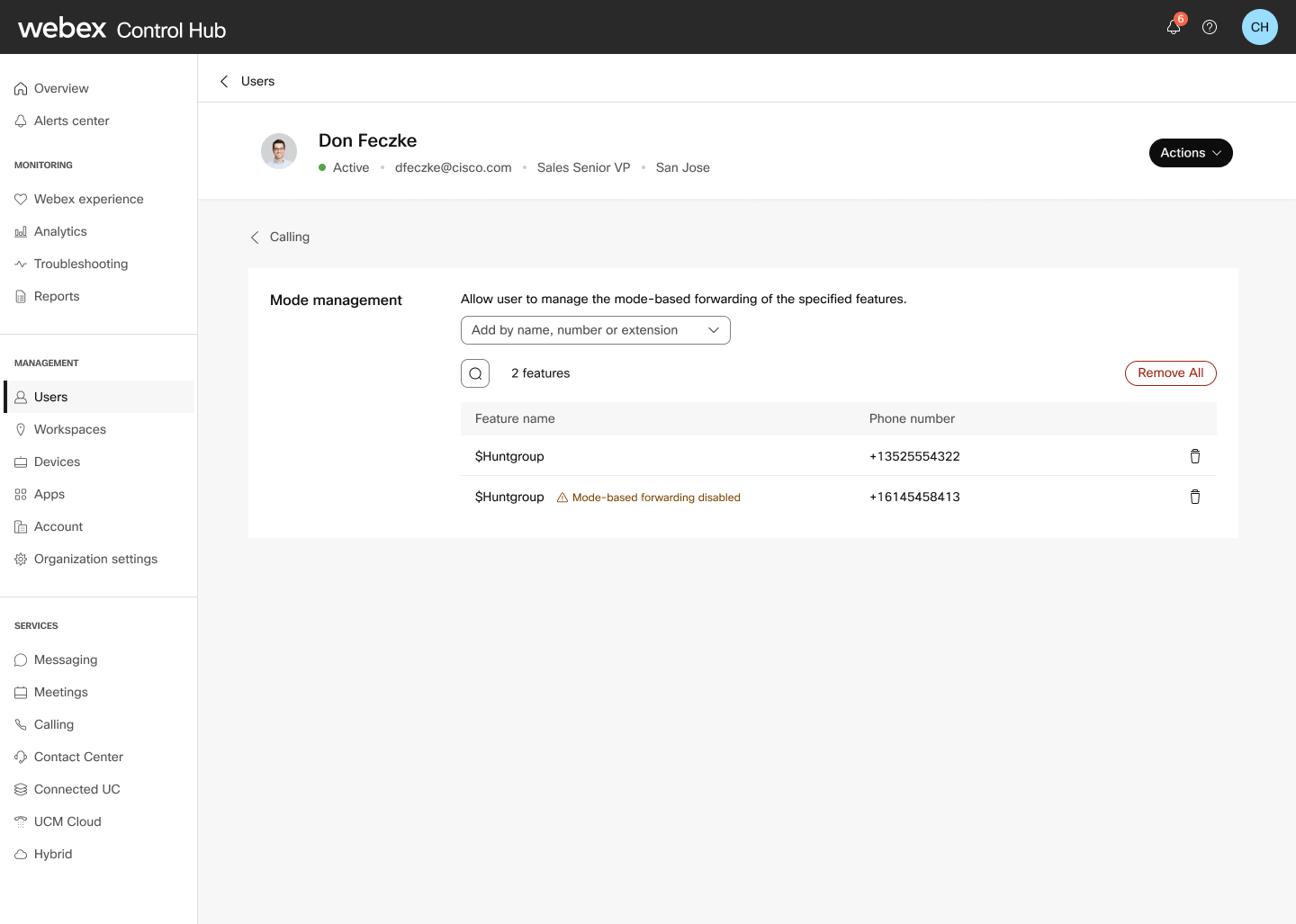
-
 을 클릭하여 기능을 삭제하거나 모두 제거 를 클릭하여 지정된 사용자의 모든 기능을 제거합니다.
을 클릭하여 기능을 삭제하거나 모두 제거 를 클릭하여 지정된 사용자의 모든 기능을 제거합니다. - 새로운 기능이 목록에 나타납니다.
 를 사용하여 기능을 필터링합니다.
를 사용하여 기능을 필터링합니다.
사용자 허브에서 모드 관리
관리자 또는 사무실 관리자는 사용자 허브를 통해 모드를 관리하고 예약된 작업 모드로 기능의 통화 전달 설정을 관리할 수 있습니다.
- 사용자 허브에 로그인하세요.
-
 을 클릭하세요 > > .
을 클릭하세요 > > . 표에는 기능 이름, 전화번호, 내선번호, 전달 대상지, 현재 모드가 표시되어 있습니다.
- 기능을 선택하여 세부 정보를 보고 모드를 관리하세요.
셰브론 버튼을 사용하여 일정 이름(모드)을 확장하고 일정 정보를 확인하세요.
- 모드 편집 을 클릭하여 모드를 전환하거나 모드를 확장하세요.
자세한 내용은 예제 섹션을 참조하세요.
대량 모드 전환 수행
관리자나 사무실 관리자는 여러 기능이나 부서를 선택하여 대량 또는 일괄 모드 전환을 수행할 수 있습니다. 이렇게 하면 선택한 모든 기능에 동일한 적용 모드가 적용됩니다.
보편적으로 적용 가능한 모드가 없는 기능을 선택한 경우, 대량 모드 전환을 계속하려면 위치에 따라 선택 사항을 조정하세요.
-
 을 클릭하세요 > > .
을 클릭하세요 > > . - 기능을 선택하고 모드 전환을 클릭하세요.
- 선택된 기능에 대해 전환하고자 하는 공통 모드를 선택하십시오.
일괄 전환 모드에서는 수동으로 정상 모드로만 되돌릴 수 있습니다.
- 모드 전환을 클릭하세요.
장치 지원
모드 관리 권한이 있는 사용자는 할당된 98xx 및 88xx 장치(8831, 8832 제외)에서 관리자가 정의한 일정을 보고 수동으로 재정의할 수 있습니다. 장치당 최대 5개의 모드 관리 라인 키가 지원됩니다.
권한이 있는 사용자는 모드를 관리하기 위해 기능에 참여할 필요는 없습니다. 예를 들어, 사용자는 통화 대기열에서 상담원으로 지정될 필요가 없습니다.
Control Hub의 장치 라인 키 레이아웃과 라인 키 템플릿이 모드 관리 라인 키 할당 값을 지원하도록 향상되었습니다.
-
모드 관리 기능은 모드 관리 값이 할당된 줄 키에만 나타납니다.
-
모드 관리 기능은 open 값으로 할당된 줄 키에 나타나지 않습니다.
-
모드 관리 라인 키가 나타나려면 장치에서 사용자 지정 레이아웃을 사용해야 합니다.
-
모드 관리 라인 키는 작업 공간 장치에서 지원되지 않습니다. 작업 공간 장치에서 모드 관리 라인 키를 설정하기 위한 API 요청이 거부되었습니다. 모드 관리 줄 키가 포함된 장치 템플릿이 작업 공간 장치에 적용되는 경우, 모드 관리 줄 키는 대신 열린 줄 키로 처리됩니다.
-
모드 관리를 위해 장치 소유자에게 할당된 기능보다 많은 모드 관리 모양이 장치에 구성된 경우 경고가 표시됩니다. 모드 관리를 위해 장치 소유자에게 할당된 기능보다 장치에 구성된 모드 관리 모양이 적은 경우 경고는 표시되지 않습니다.
사용자 지정 장치의 프로비저닝 모드 관리
기본 레이아웃을 적용하려면:
-
Control Hub에 로그인합니다.
-
호출 > > .
-
라인 키 템플릿 재설정 을 선택하여 일치하는 장치의 구성을 기본 템플릿으로 재설정합니다. 이렇게 하면 사용자 정의 라인 키 설정도 무시됩니다.
-
위치와 장치를 입력하세요. 이러한 방법으로 검색하려면 태그로 검색 구체화 또는 권고사항으로 검색 구체화 를 선택하세요. 필요에 따라 상자를 체크하세요.
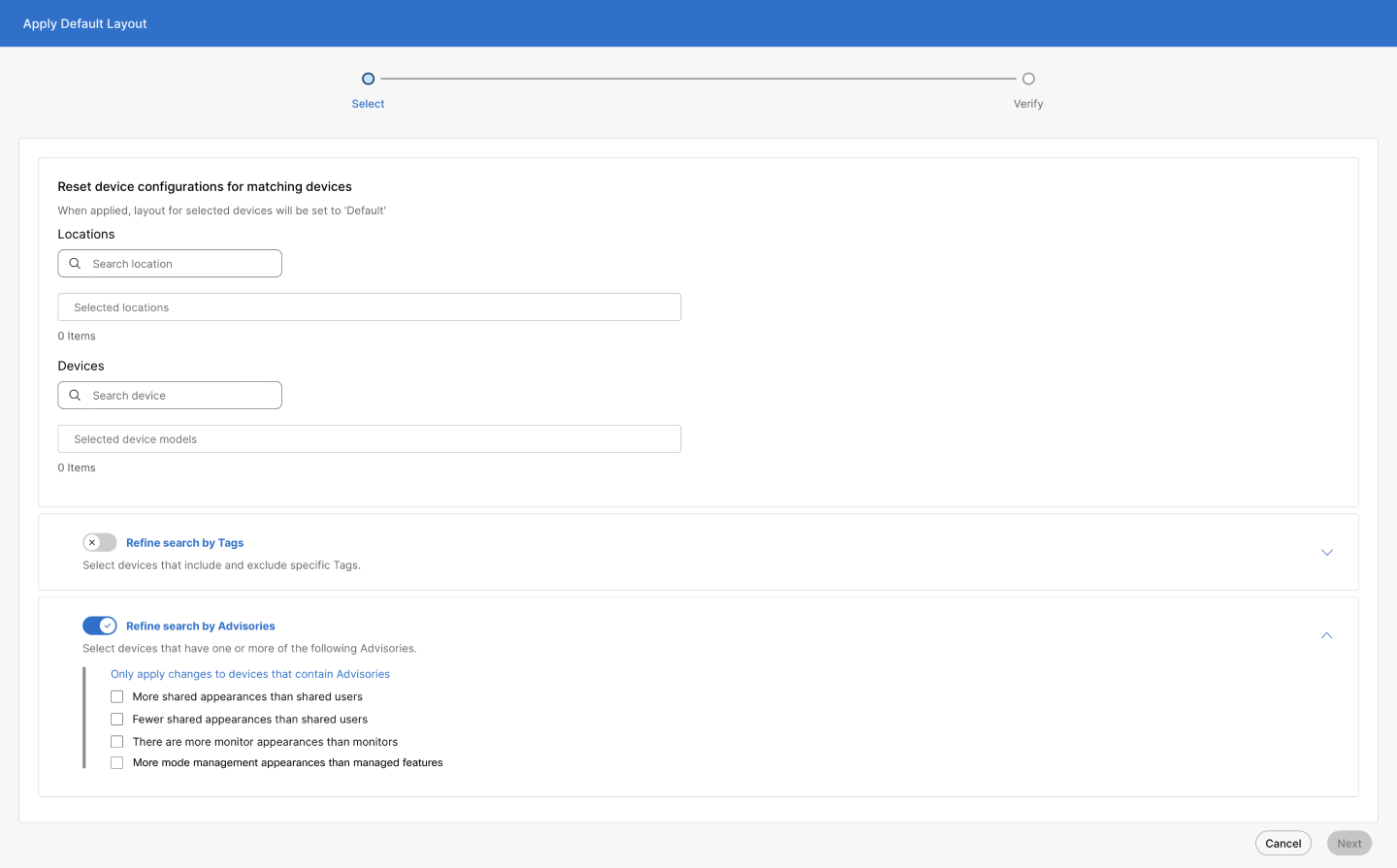
-
다음을 클릭합니다. 선택한 장치의 구성 레이아웃은 적용되면 기본 레이아웃 으로 설정됩니다. 변경 사항은 장치가 동기화되면 적용됩니다.
-
기본값으로 재설정을 선택하세요.
사용자 지정 레이아웃을 적용하려면:
-
사용자 정의 레이아웃 적용 아이콘을 선택하여 일치하는 모든 장치에 템플릿을 찾아 적용합니다.
-
위치와 장치를 입력하세요. 이러한 방법으로 검색하려면 태그로 검색 구체화 또는 권고사항으로 검색 구체화 를 선택하세요. 필요에 따라 상자를 체크하세요.
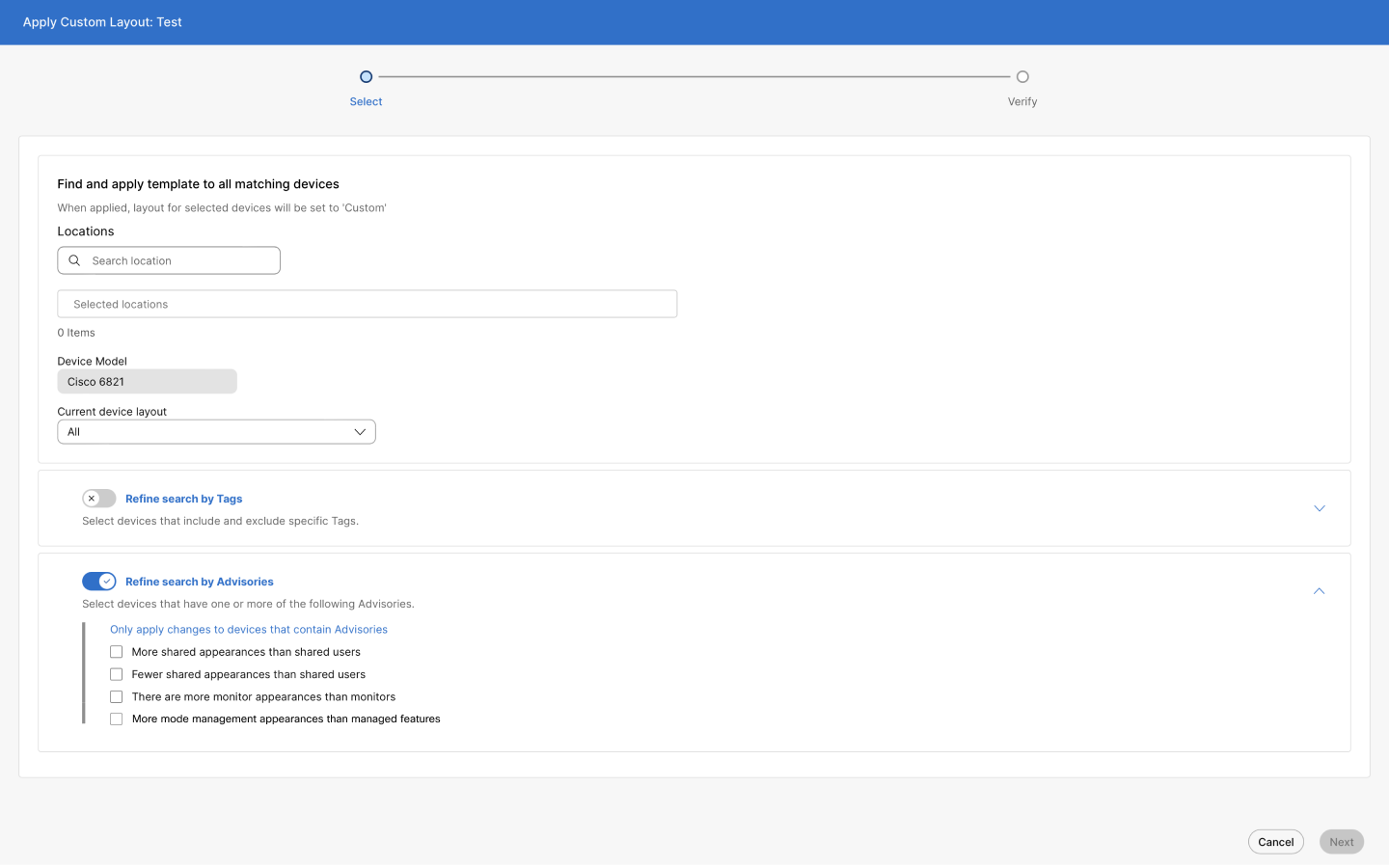
현재 장치 레이아웃의 기본 레이아웃 을 선택하면 모드 관리 확인란이 비활성화됩니다. 모두 를 선택하면 모드 관리 체크박스가 활성화됩니다.
-
다음을 클릭합니다. 선택한 장치의 구성 레이아웃은 적용되면 사용자 정의 레이아웃 으로 설정됩니다. 변경 사항은 장치가 동기화되면 적용됩니다.
-
사용자 정의 레이아웃 적용을 선택합니다.
템플릿을 편집하려면:
-
 을(를) 클릭합니다.
을(를) 클릭합니다. -
줄 키 할당과 순서가 나타납니다. 각 드롭다운을 확장하여 줄 키 할당을 선택합니다.
-
모드 관리 를 선택하고 저장을 클릭합니다.
장치에 개별적으로 모드 관리를 할당하려면:
-
장치 로 이동하여 장치를 선택하세요.
-
레이아웃 구성 옆에 있는 관리 를 클릭합니다.
-
기본, 공유 회선 또는 통화 기능으로 회선 키를 프로그래밍하고 변경 사항을 저장하여 현재 구성을 재정의합니다. 사용자 정의 레이아웃을 선택하세요. 드롭다운 목록을 사용하여 라인 키에 대한 모드 관리 를 선택하세요.
-
레이아웃 미리보기 상자를 체크하면 미리보기 모드에서 라인 구성을 볼 수 있습니다. 프로비저닝이 완료되면 장치에 다음과 같이 표시됩니다.
-
저장을 클릭합니다.
제한 사항
-
최대 100개의 조직 수준 운영 모드를 구성할 수 있습니다.
-
위치당 최대 100개의 위치 수준 운영 모드를 구성할 수 있습니다.
-
최대 150개의 휴일 구성이 지원됩니다.
-
8831 및 8832 장치 모델은 지원되지 않습니다.
-
키 확장 모듈이 지원되지 않습니다.
-
모드 관리 라인 키는 작업 공간 장치에서 지원되지 않습니다.
실제 사례: 전기 기술자 사무실 전화 라우팅
전기 기술자 사무실에서는 운영 모드를 통해 어떻게 유연한 통화 처리를 제공하는지 보여줍니다.
표준 작업
|
모드 |
예약 |
통화 라우팅 |
|
일 |
오전 9시 ~ 오후 4시 (월요일) |
대기 중인 에이전트 |
|
점심 식사 중 |
오후 12시 ~ 오후 1시 (월요일) |
접수원 |
|
밤 |
오후 4시 ~ 다음날 오전 9시 (월요일) |
나이트 매니저 |
|
공휴일 및 주말 |
애드혹 |
보이스메일 |
통화 모니터링 및 수정
사무실 관리자는 다음을 통해 통화 라우팅을 관리할 수 있습니다.
-
지정된 전화기
-
User Hub
설정
주간, 점심시간, 야간, 공휴일 및 주말의 4가지 운영 모드를 만듭니다. 주간, 점심, 야간 모드는 예약 모드입니다. 공휴일과 주말은 비정기 모드입니다.
-
주간 모드
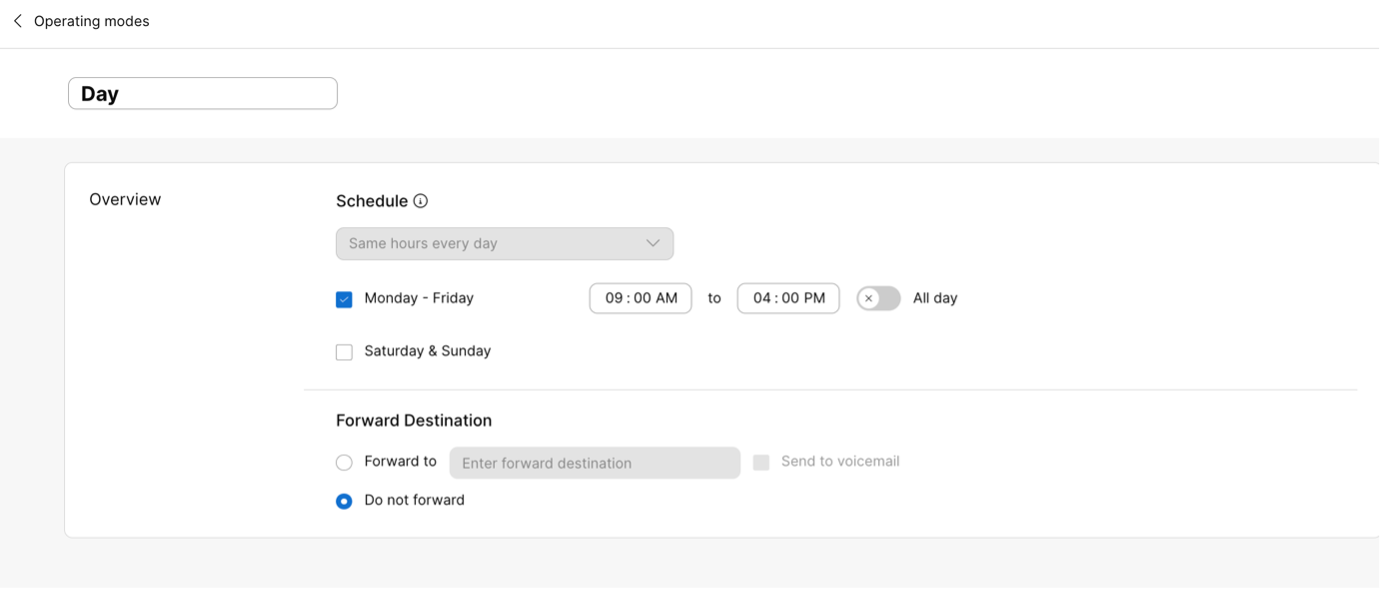
-
점심 모드
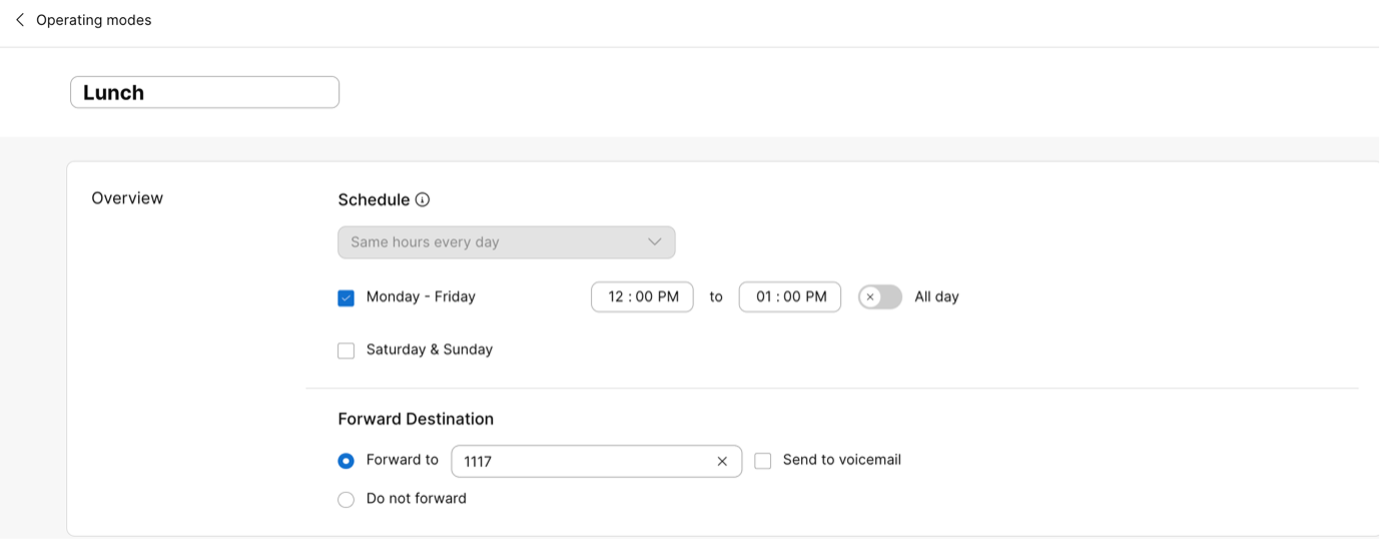
-
야간 모드

-
공휴일 및 주말

전기 기술자 사무실의 주요 회선에 모드 기반 전달을 구성합니다.
전기 기술자 사무실의 주요 회선은 모드 기반 전달이 구성된 통화 대기열 에 할당됩니다.
-
을 선택하고 통화 대기열을 선택하세요.
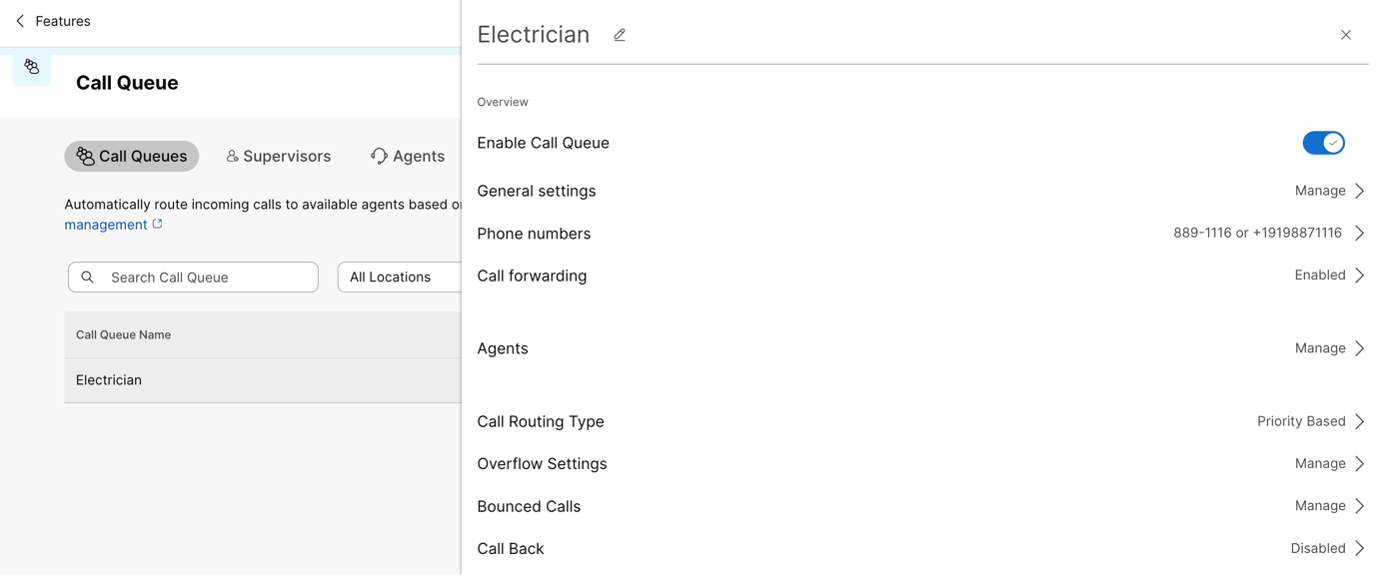
-
통화 전달에서 [모드별 통화 전달 을 활성화합니다.
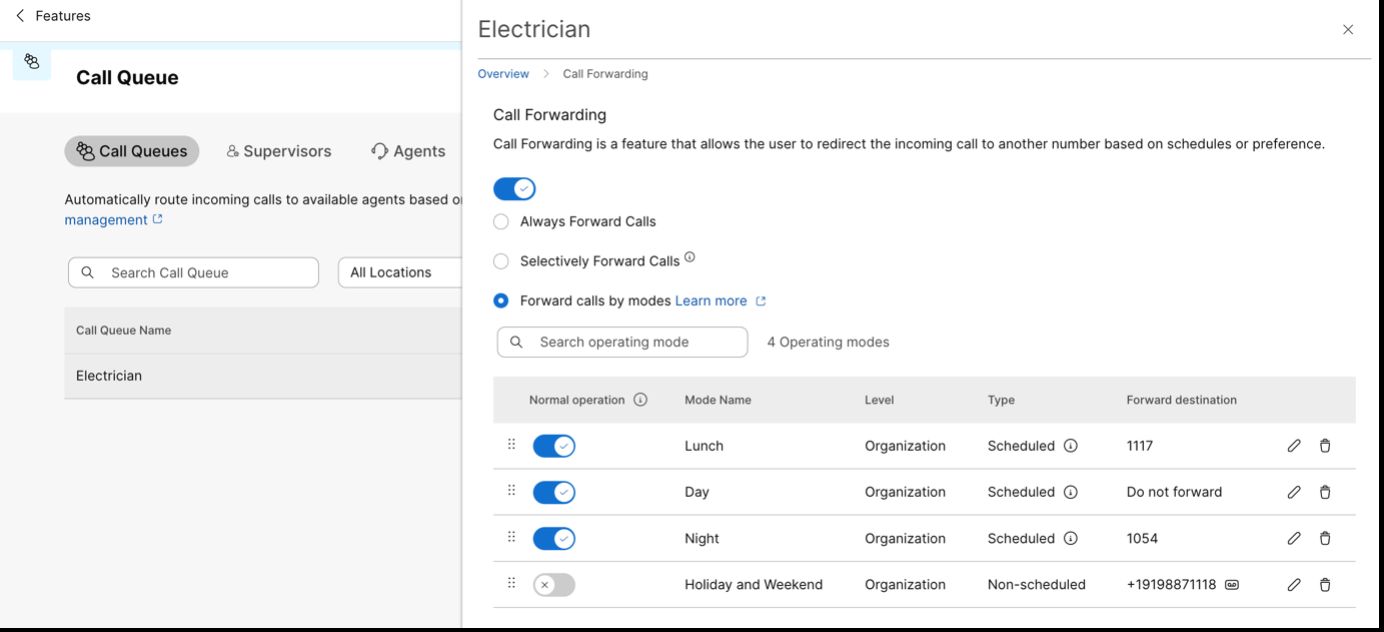
주간, 점심시간, 야간, 휴일, 주말 모드가 순서대로 추가됩니다. 주간 모드와 점심 모드는 일정이 겹치므로, 점심 모드가 주간 모드보다 우선순위가 높습니다.
주간 모드에는 전달 대상이 정의되어 있지 않으므로 통화는 통화 대기열에 있는 상담원에게 라우팅됩니다.
-
모드 관리자를 지정합니다.
를 선택하고 모드 관리를 선택합니다. 통화 대기열(또는 통화 라우팅을 수정해야 하는 번호의 기능)을 찾아 선택한 다음 저장을 클릭합니다.

-
장치의 라인 키 템플릿을 수정합니다.
장치가 모드 관리자에 할당된 경우 라인 키 템플릿을 업데이트하고 모드 관리 를 적절한 비기본 라인 키에 할당합니다.
이를 수행하려면 연결된 장치에 액세스하고 레이아웃 구성을 선택하고 사용자 지정 레이아웃 옵션을 선택합니다. 이전에 모드 관리로 만든 사용자 정의 템플릿을 선택하고 적용을 클릭합니다.
또는 드롭다운 목록에서 모드 관리 를 선택할 수 있습니다. 변경 사항을 적용하려면 저장 및 적용 구성을 클릭하세요.

데스크폰에서 운영 모드 수정
시나리오 1
현재 운영모드는 휴일 및 주말로 설정되어 있습니다. 그러나 업무량이 많아서 전기 기술자 사무실은 주말부터 일찍 돌아왔습니다. 이에 따라 사무실 관리자는 모드를 주간 모드로 설정했습니다.
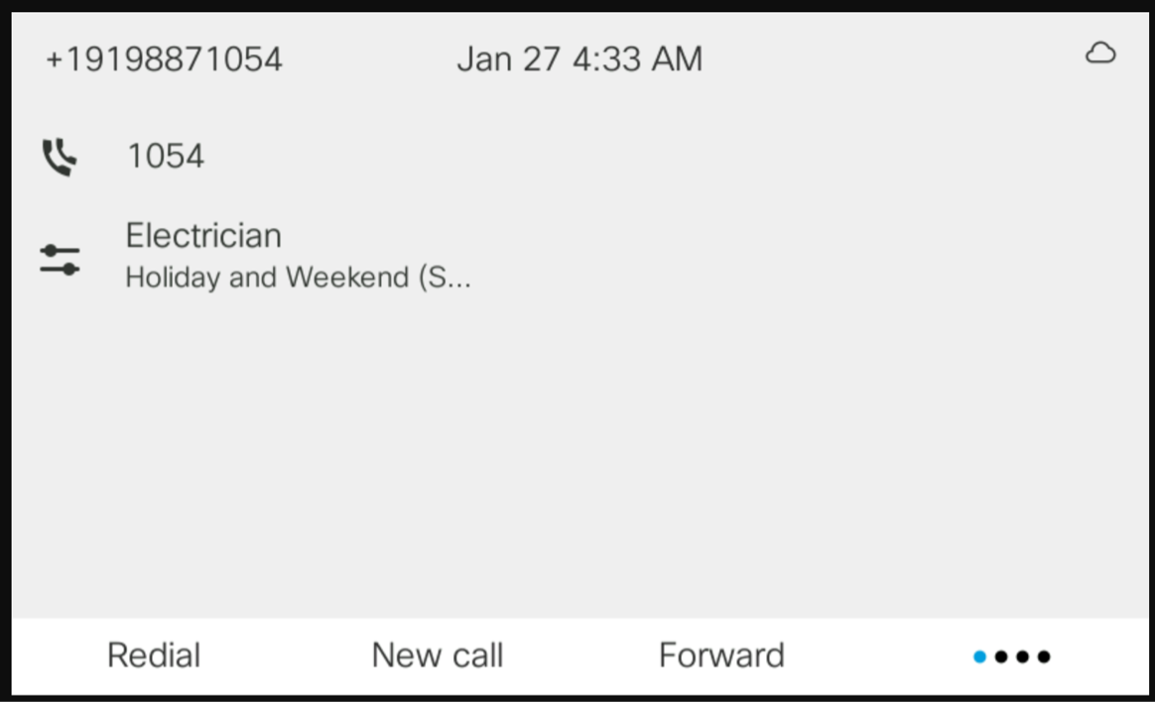
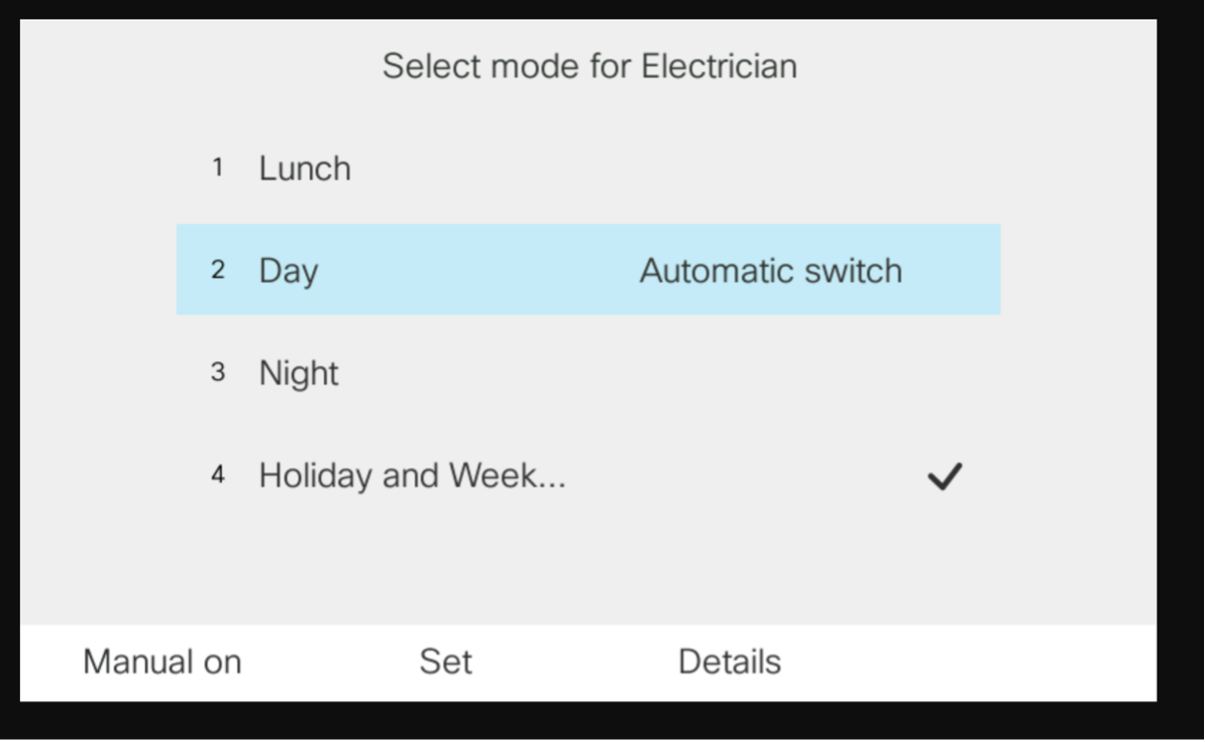
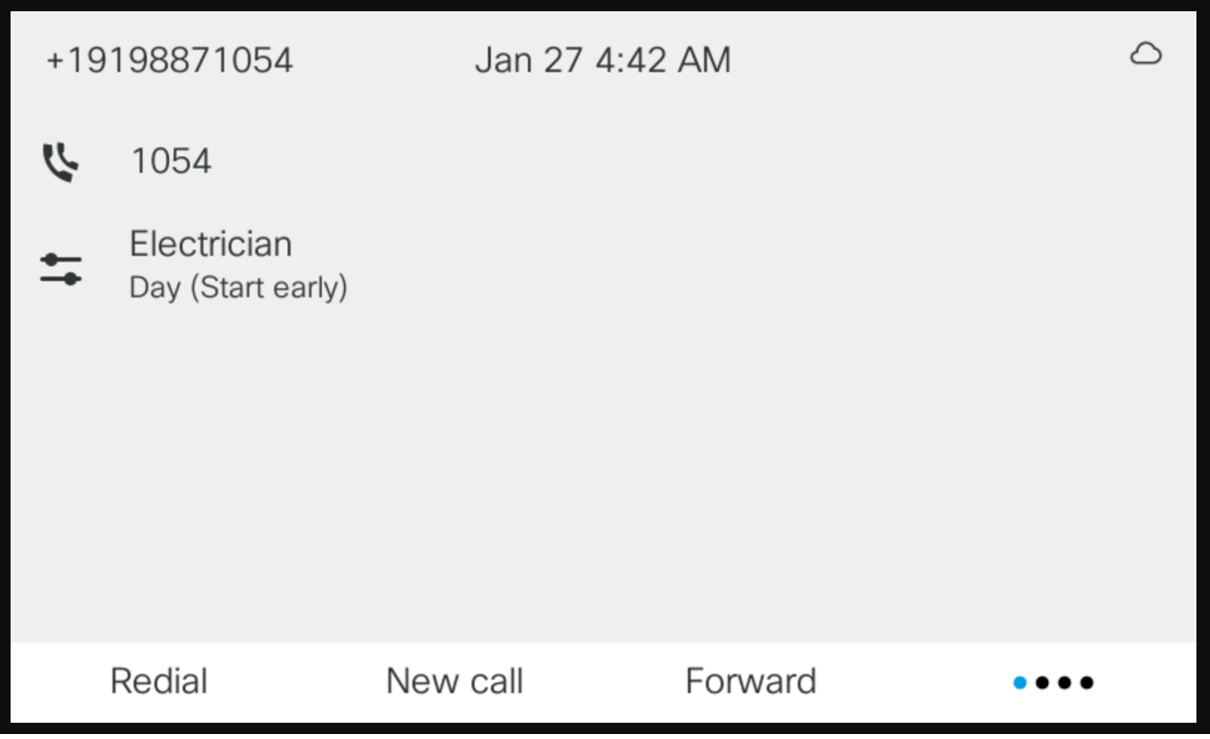
시나리오 2
전기 기술자 사무실 직원들은 예상보다 점심시간이 길어지면서 아직 점심시간입니다. 그래서 그들은 그것을 한 시간 연장하고 싶어합니다. 사무실 관리자가 기존 점심시간을 한 시간 연장합니다.
